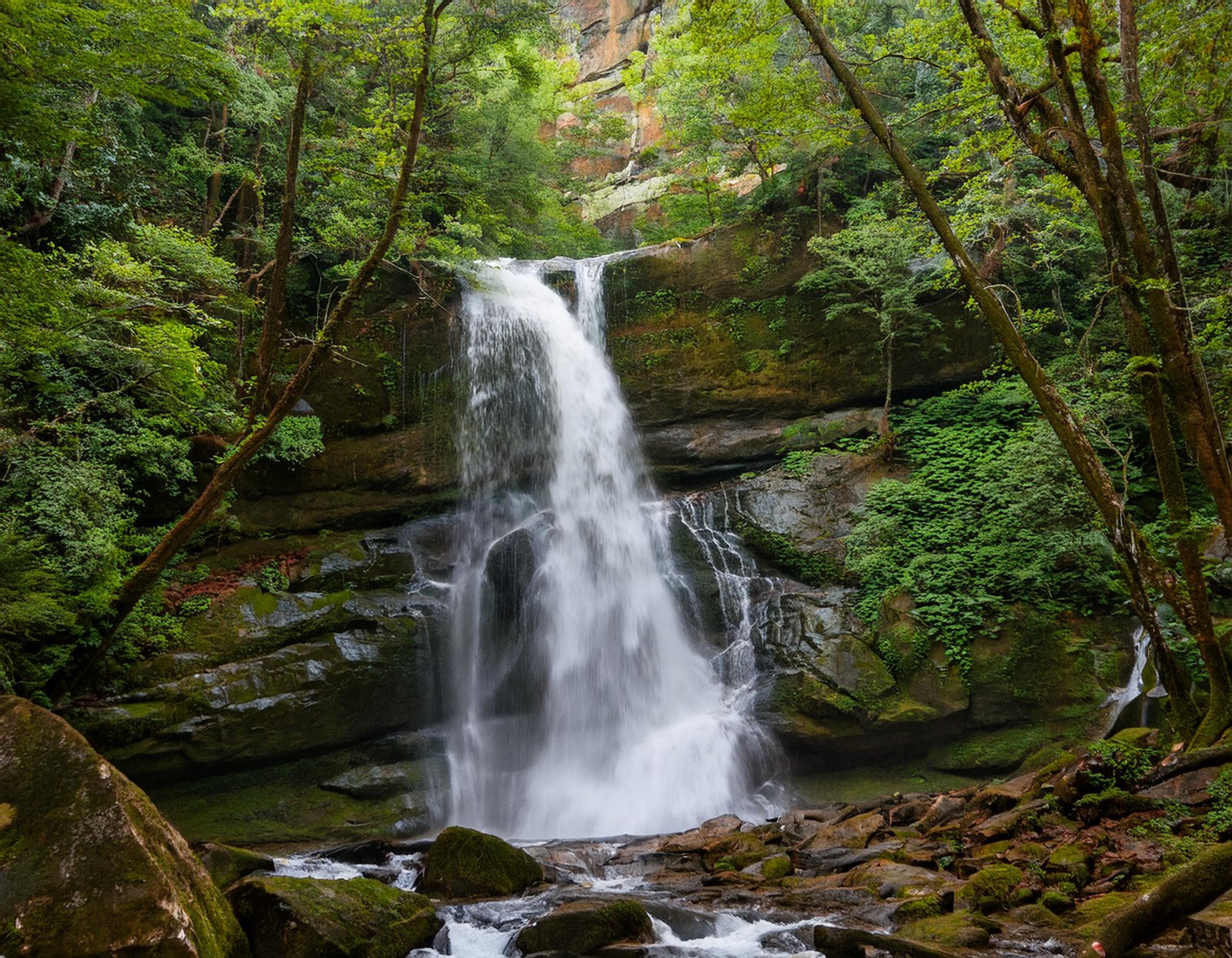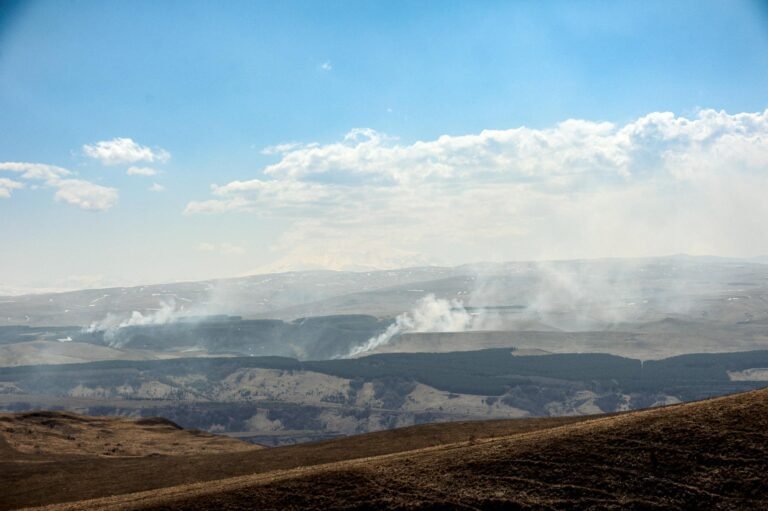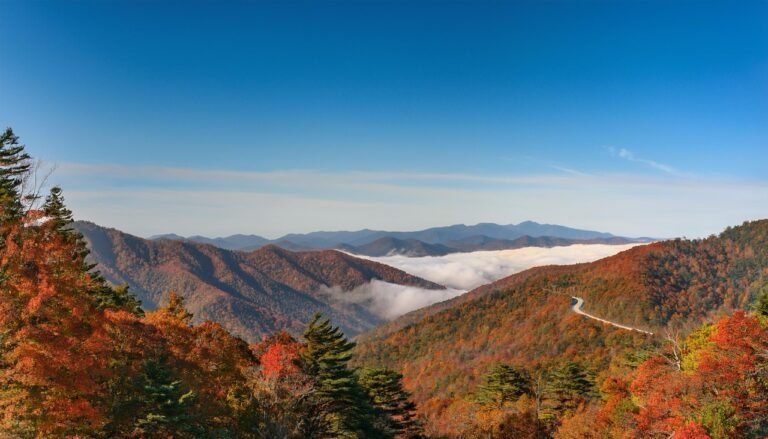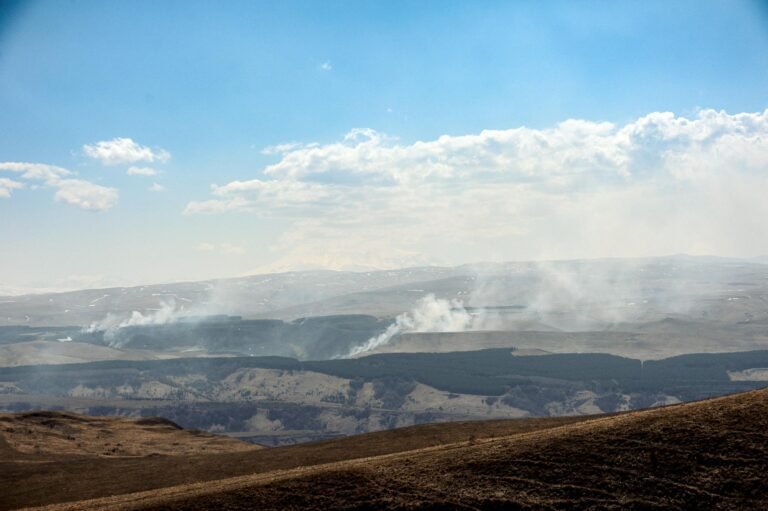Great Smoky Mountains National Park Waterfalls
Waterfall Wonderland
The Great Smoky Mountains National Park is a dream come true for waterfall lovers, with over 100 stunning waterfalls and cascades. Thanks to more than 85 inches of rain each year, the park is a lush haven, crisscrossed by over 2,000 miles of streams and rivers. This constant downpour, paired with the park’s steep terrain, makes it a perfect spot for waterfalls. From towering peaks like Mt. Le Conte and Clingmans Dome, water tumbles down the mountainsides, sometimes dropping over a mile to the foothills below.
| Waterfall Feature | Description |
|---|---|
| Total Prominent Waterfalls | Over 100 |
| Annual Rainfall | 85+ inches |
| Length of Streams | 2,000 miles |
| Visitor Count | 200,000+ annually |
You can find all sorts of waterfalls here, from grand, jaw-dropping falls to smaller, hidden treasures. If you’re planning a visit, grab a guide to help you find over 40 of the best waterfalls. These guides come with detailed maps, photos, and trailhead info, making it a breeze to discover these natural beauties. For more details on the park’s layout, check out the Great Smoky Mountains National Park map.
Must-See Waterfalls
While the park is packed with waterfalls, some are real crowd-pleasers. Here are a few of the most popular ones in the Great Smoky Mountains National Park:
- Grotto Falls
- Laurel Falls
- Abrams Falls
- Rainbow Falls
Each of these waterfalls offers something special and can be reached via well-marked trails. Grotto Falls is a hit because you can actually walk behind the waterfall. Laurel Falls is an easy hike, perfect for families. Abrams Falls is a bit tougher but rewards you with a breathtaking view and a cool plunge pool. Rainbow Falls is famous for the rainbow that appears in its mist on sunny days.
| Waterfall | Hiking Distance | Trail Difficulty |
|---|---|---|
| Grotto Falls | 2.6 miles round trip | Moderate |
| Laurel Falls | 2.3 miles round trip | Easy |
| Abrams Falls | 5 miles round trip | Moderate to Strenuous |
| Rainbow Falls | 5.4 miles round trip | Strenuous |
These popular spots can get pretty crowded, especially during peak times. For a quieter experience, try visiting early in the morning or on weekdays. For more hiking options, check out our guide to the best hikes in Great Smoky Mountains National Park.
With so many waterfalls to explore, the Great Smoky Mountains National Park is a paradise for adventurers. Whether you’re after a family-friendly stroll or a challenging hike, there’s a waterfall waiting for you. For more fun activities during your visit, take a look at our list of things to do in Great Smoky Mountains National Park.
Safety Tips for Hikers
Hiking in the Great Smoky Mountains National Park is a treat for the eyes and soul, with jaw-dropping views and mesmerizing waterfalls. But hey, let’s not forget safety! Being prepared and aware of potential hazards is key to having a blast without any hiccups.
Watch Out for These Hazards
Nature’s beauty comes with its quirks. Here are a few things to keep an eye on while exploring the Great Smoky Mountains:
- Rough Terrain: Trails can be rocky, steep, and uneven. Good hiking shoes with solid grip are your best buddies here.
- Slippery Surfaces: Waterfall areas can be as slick as a banana peel. Be cautious and steer clear of wet rocks.
- Weather Changes: The weather can flip faster than a pancake. Check the weather forecast before you head out.
Water Treatment Tips
Drinking untreated water in the park? Bad idea. Giardia lamblia, a nasty little protozoan, can ruin your trip. Here’s how to keep your water safe:
- Boiling Water: Boil it for at least a minute to kill any creepy crawlies.
- Using Filters: Use filters that can snag particles as tiny as 1 micron.
| Water Treatment Method | Effectiveness |
|---|---|
| Boiling for 1 minute | High |
| 1-micron filter | High |
For more tips, check out our guide on camping in the Smokies.
Beat Hypothermia
Hypothermia can sneak up on you, even in summer. Sudden weather changes can make you feel like you’re in a freezer. Here’s how to stay warm:
- Dress Smart: Layer up with synthetic or woolen clothes. Ditch the cotton—it holds onto moisture like a sponge.
- Rain Gear: Always pack waterproof jackets and pants.
- Stay Hydrated: Drink water to keep your body temp in check.
- Weather Watch: Keep an eye on the sky and check updates at the visitor center.
For more hiking safety tips, swing by our article on the best hikes in the Smokies.
Wildlife Encounters
Visiting the Great Smoky Mountains National Park is like stepping into a nature documentary. The park is teeming with wildlife, and while it’s thrilling to see animals up close, it’s also important to stay safe. Let’s talk about some of the critters you might meet and how to handle those encounters.
Get more information on National Parks
Bears in the Park
The Great Smoky Mountains are bear country. Black bears roam these woods, and spotting one can be the highlight of your trip. But remember, they’re not teddy bears. Bear attacks are rare, but they do happen. Carrying bear spray is a smart move—think of it as your bear insurance. Only use it if a bear gets too close for comfort.
When you’re out hiking or chasing waterfalls like Ramsey Cascades or Rainbow Falls, make some noise. Clap, chat, or even sing a little tune to let bears know you’re coming. If you do bump into one, stay cool, back away slowly, and whatever you do, don’t run. For more tips, swing by the Great Smoky Mountains National Park Visitor Center.
| Bear Safety Tips | What to Do |
|---|---|
| Make Noise | Clap, talk, or sing to avoid surprising bears. |
| Carry Bear Spray | Use it only if a bear gets too close. |
| Stay Calm | Back away slowly; don’t run. |
Venomous Snakes Alert
The park is also home to some slithery residents: the northern copperhead and the timber rattlesnake. Snake bites are rare, but it’s good to be cautious. Watch where you step and where you put your hands, especially around old buildings, stone fences, and thick bushes.
If you see a snake, give it space. Don’t try to be a hero and handle it. If you do get bitten, get medical help right away. Keeping an eye on your surroundings can make your visit to the Great Smoky Mountains National Park a lot safer.
| Snake Safety Tips | What to Do |
|---|---|
| Watch Your Step | Be careful where you place your hands and feet. |
| Give Space | Don’t approach or handle snakes. |
| Seek Medical Attention | Get help immediately if bitten. |
By following these tips, you can enjoy the stunning great smoky mountains national park waterfalls and all the natural beauty the park has to offer. For more info on planning your trip, check out the Great Smoky Mountains National Park Lodging and Great Smoky Mountains National Park Camping pages.
Must-See Waterfalls
Taking a trip to the Great Smoky Mountains National Park? You’re in for a treat! The park’s waterfalls are a sight to behold, perfect for families looking to soak in some natural beauty. Let’s dive into two of the park’s standout waterfalls: Meigs Falls, The Sinks, and Place of a Thousand Drips.
Meigs Falls and The Sinks
These two gems are crowd favorites, each with its own special charm.
Meigs Falls sits right along Little River Road, making it super easy to get to. This spot is all about peace and quiet, with a view that’s picture-perfect. You can catch a glimpse from the road or take a short stroll for a closer look.
The Sinks is where Little River shows off its power, creating a stunning cascade. Located about 12 miles west of the Sugarlands Visitor Center, this waterfall is a hit with photographers and nature lovers alike, thanks to its dramatic water flow.
| Waterfall | Location | What Makes It Special |
|---|---|---|
| Meigs Falls | Little River Road | Serene and easy to reach |
| The Sinks | 12 miles west of Sugarlands Visitor Center | Powerful flow of Little River |
Need more info? Check out our park map and weather guide.
Place of a Thousand Drips
Place of a Thousand Drips is another must-see. When it rains, this waterfall splits into countless tiny streams, creating a mesmerizing display. It’s a unique sight that’s sure to leave an impression.
To get there, turn at traffic light #8 in Gatlinburg, follow Historic Nature Trail into the park, and take Roaring Fork Motor Nature Trail (just remember it’s closed in winter) to stop #15.
| Waterfall | How to Get There | What Makes It Special |
|---|---|---|
| Place of a Thousand Drips | Turn at traffic light #8 in Gatlinburg, follow Historic Nature Trail, Roaring Fork Motor Nature Trail (stop #15) | Water splits into numerous small channels |
Want to make the most of your visit? Check out our guide on the best hikes in the park.
Visiting these waterfalls will give you and your family a chance to enjoy the park’s stunning natural beauty and create lasting memories. For more fun activities, see our guide on things to do in the park.
Tallest Waterfalls in the Park
If you’re visiting the Great Smoky Mountains National Park, checking out the tallest waterfalls is a must. These falls are not just tall; they’re jaw-dropping. Let’s talk about two of the park’s giants: Ramsey Cascades and Rainbow Falls.
Ramsey Cascades
Ramsey Cascades is the big boss of waterfalls in the Smokies, standing at a whopping 100 feet. It’s a sight that’ll make you forget about your Instagram feed for a moment. The hike to get there? Well, it’s a bit of a workout, but trust me, it’s worth every step.
The trail is about 4 miles one way, so you’re looking at an 8-mile round trip. You’ll wander through ancient forests and hop over a few streams. The path is well-marked, and you’ll get to see some cool plants and critters along the way. Just remember to pack plenty of water and wear some good hiking boots.
For more info on hiking trails, check out Great Smoky Mountains National Park Hiking Trails.
| Waterfall | Height (feet) | Trail Length (miles) | Difficulty |
|---|---|---|---|
| Ramsey Cascades | 100 | 8 (round trip) | Moderate to Hard |
Rainbow Falls
Next up, we have Rainbow Falls, the tallest single-drop waterfall in the park, standing at 80 feet. The name comes from the rainbow you can see in the mist on sunny afternoons. It’s like nature’s own light show.
The hike to Rainbow Falls is about 2.7 miles one way, making it a 5.4-mile round trip. The trail has some steep and rocky parts, so it’s a bit of a challenge, but nothing too crazy. You’ll be surrounded by lush greenery and the sound of rushing water. Aim to visit in the afternoon to catch that rainbow magic.
For more tips on what to do in the park, visit Things to Do in Great Smoky Mountains National Park.
| Waterfall | Height (feet) | Trail Length (miles) | Difficulty |
|---|---|---|---|
| Rainbow Falls | 80 | 5.4 (round trip) | Moderate |
Checking out these waterfalls is a fantastic way to soak in the natural beauty of the Great Smoky Mountains. Don’t forget to swing by the Great Smoky Mountains National Park Visitor Center for maps and more info before you head out. Happy hiking!
Current Events and Alerts
Visitors to the Great Smoky Mountains National Park should be aware of ongoing improvements and changes to some of the park’s popular waterfall trails. Notably, the Laurel Falls Trail is undergoing significant enhancements to improve visitor experience and safety.
These improvements include widening and resurfacing the trail, constructing a new viewing platform, and expanding parking facilities. As a result, the trail is expected to be closed for approximately 18 months starting in 2024.
Additionally, while the Laurel Falls Trail is closed, visitors are encouraged to explore other beautiful waterfall hikes such as Grotto Falls, Rainbow Falls, and Abrams Falls.
These trails offer unique experiences and stunning views, ensuring that visitors can still enjoy the park’s renowned waterfalls during this period.
Biodiversity in the Park
Great Smoky Mountains National Park is a goldmine of life, perfect for nature lovers and families. Let’s dive into the amazing variety of species here and the cool All Taxa Biodiversity Inventory (ATBI) project.
Unique Species Diversity
This park is bursting with life, thanks to its many water sources and different elevations. So far, 21,980 species have been found, with over half of these discovered since 1998. This makes it one of the most biodiverse spots on the planet.
| Species Type | Number of Species |
|---|---|
| Total Documented Species | 21,980 |
| New Species Since 1998 | 10,990 |
| New to Science | 877 |
| Known Elsewhere, New to Park | 5,251 |
The park’s biodiversity includes a wild mix of plants, animals, fungi, and microorganisms. From black bears to tiny wildflowers, the variety is mind-blowing. The park’s unique setup gives these species the perfect place to live and grow. Curious about the park’s layout? Check out the Great Smoky Mountains National Park map.
All Taxa Biodiversity Inventory
The All Taxa Biodiversity Inventory (ATBI) is a groundbreaking project aiming to catalog every species within the park. Partnering with groups like Discover Life in America, this project has hugely boosted our knowledge of the park’s biodiversity.
The ATBI has nearly doubled the number of known species since it started. It’s not just about counting species but also about keeping an eye on their populations and making sure they have what they need to survive.
| ATBI Achievements | Numbers |
|---|---|
| Species Documented by ATBI | 15,559 |
| New Species to Science | 877 |
| Species Known Elsewhere, New to Park | 5,251 |
Visitors can help with this ongoing research. By snapping photos of wildlife and uploading them to apps like iNaturalist, you can add valuable data to the ATBI. This public involvement is key to the project’s success and helps in discovering and monitoring species.
The lessons learned from the ATBI are shared nationwide to avoid repeating efforts and to use resources wisely. Planning a visit? Check out things to do in Great Smoky Mountains National Park for more info.
By understanding and appreciating the biodiversity of the Great Smoky Mountains National Park, you can have a richer, more informed visit. Explore the park’s wonders and help preserve it for future generations. For more info on where to stay, visit Great Smoky Mountains National Park lodging.








